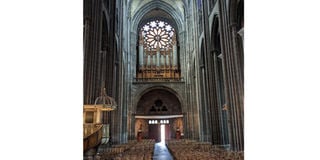Prime
The spectacular cathedral of Our Lady of the Assumption of Clermont Ferrand

Interior. Most of the ornaments and spaces in the cathedral spell holiness. Photos | Deus Bugembe
What you need to know:
- Sight to behold. The towering spectacle of Cathédrale Notre-Dame-de-l’Assomption cannot leave travellers the same, writes Deus Bugembe.
About 420km to the South of Paris, the capital of France is an ancient city, Clermont-Ferrand in the Auvergne-Rhône-Alpes, known for its volcanoes, culture and rich history. A train from Paris at the Gare de Bercy station to Clermont Ferrand goes for 64 Euros (Shs256,000) and the journey lasts about three hours. On arrival, one is greeted by the towering spectacle of Cathédrale Notre-Dame-de-l’Assomption which translates as the Cathedral of Our Lady of the Assumption. In the Catholic church, ‘Our Lady of Assumption’ is a statement that observes the belief that when Mary, the mother of Jesus Christ, died, her body was “assumed” into heaven to meet her soul, instead of going through the usual course of physical decay upon death.
The cathedral sits atop the central hill of Clermont-Ferrand and is one of those places you set your eyes on and immediately make up your mind on getting closer. The closer you get, the more magnificent it looks. Even the residents of Clermont-Ferrand cannot seem to have enough of it. Its gothic look is captivating and the holy site is listed as a French national monument by the French Ministry of Culture.
Sightly
The cathedral is situated at the junction of the various streets. The southern side of the cathedral oversees the Place de la Victoire , in the centre of which is the statue of Pope Urban II who launched the first crusade at the council of the early 1000s when The Crusades were a sequence of religious wars between Christians and Muslims broke out as both religions were attempting to take over holy sites considered sacred by both groups. These wars occurred between 1096 and 1291.
Crafted in lava stone, the walls come off black with a fading touch that pulls off the ancient look just like many cathedrals in Europe that were built as early as the 12th century. Its distinctive look is complimented by two spires seated on top, 96 metres high which can be seen from anywhere in the city. The cathedral is designed with pointed arches, rib vaults, ornate beautification and vertical proportions with uneven patterns that create a rare but catchy look.
As early as 8am in Clermont Ferrand which is 7am in Uganda, the front yard of the Cathedral is flooded by local and international tourists, reaching out for their phones for the best shot. Just as you think you have captured the best shot, another walk around this beauty gives more ideas.
The interior has a whole different level of splendour with detailed art of Catholic sculptures of different saints, Mother Mary and Jesus Christ. The ceiling is plastered with stone and curved in. The large windows painted different colours once hit by sun rays project vibrant lighting into the Cathedral. The illumination from the ever burning candles brings a holy glow that gives the perfect prayer atmosphere to visitors who take time to make their supplication. The altar is gold coated and placed on a wooden platform that spells holiness. The aura in the cathedral feels like you are in the safest space on earth. In a city where the majority of the 149,353 people are catholic, Cathédrale Notre-Dame-de-l’Assomption is treasured like a heaven on earth.

The exterior of the cathedral.
History
As early as the fifth century, the first foundations were laid and dedicated to Saints Vitalis and Agricola. It was then destroyed in 760, only to be reconstructed in 768. This second structure was again destroyed by the Normans in 915. Bishop Stephen II built a third Romanesque cathedral, which was sanctified in 946 and served as an archetype for many churches in the Auvergne region. In 1248, moved by a visit to Sainte-Chapelle on a trip to Paris, Bishop Hugues de la Tour decided to launch work on a new cathedral to replace a Romanesque cathedral located in the same place, which itself had replaced two other Catholic churches.
Saint-Vital and Saint-Agricol were the first patrons of the Cathedral. Saint Vital was a slave and martyr while Agricole was his master, they are both celebrated every November 4 after dying in Bologna (Italy) in 304, during the persecution declared by Roman Emperor Diocletian.
The present structure was however first raised in the 13th century and also the first time volvic stone, a volcanic rock which was widely used in constructions around Clermont-Ferrand and Riom was used. It has a number of colours but light gray and black hues are the commonest.
During the French Revolution in 1879, rioters wanted to burn it down but the Benedictine Verdier-Latour managed to convince them that it would be a good meeting place for the people.
The finish
The completion works would kick off in 1866 . In 1884, the western side was completed, with full respect for construction methods of the Middle Ages . A little-noticed detail is that the building was completely painted with lines to imitate masonry and cut stone blocks. The access steps on the rue des Gras were not built, however, until the beginning of the 20th century, to make space for which the birthplace of Blaise Pascal was destroyed. The beginning of the 20th century saw the final stage start and get completed. It is now believed to be about 775 years old. It was also the seat of the Archbishops of Clermont until 2002.
QUICK NOTES
Affiliation: Roman Catholic Church
Province: Archdiocese of Clermont
Region: Auvergne
Ecclesiastical or organizational status: Cathedral
Location: Clermont Ferrand
It is the seat of the Archbishops of Clermont (bishops until 2002).




